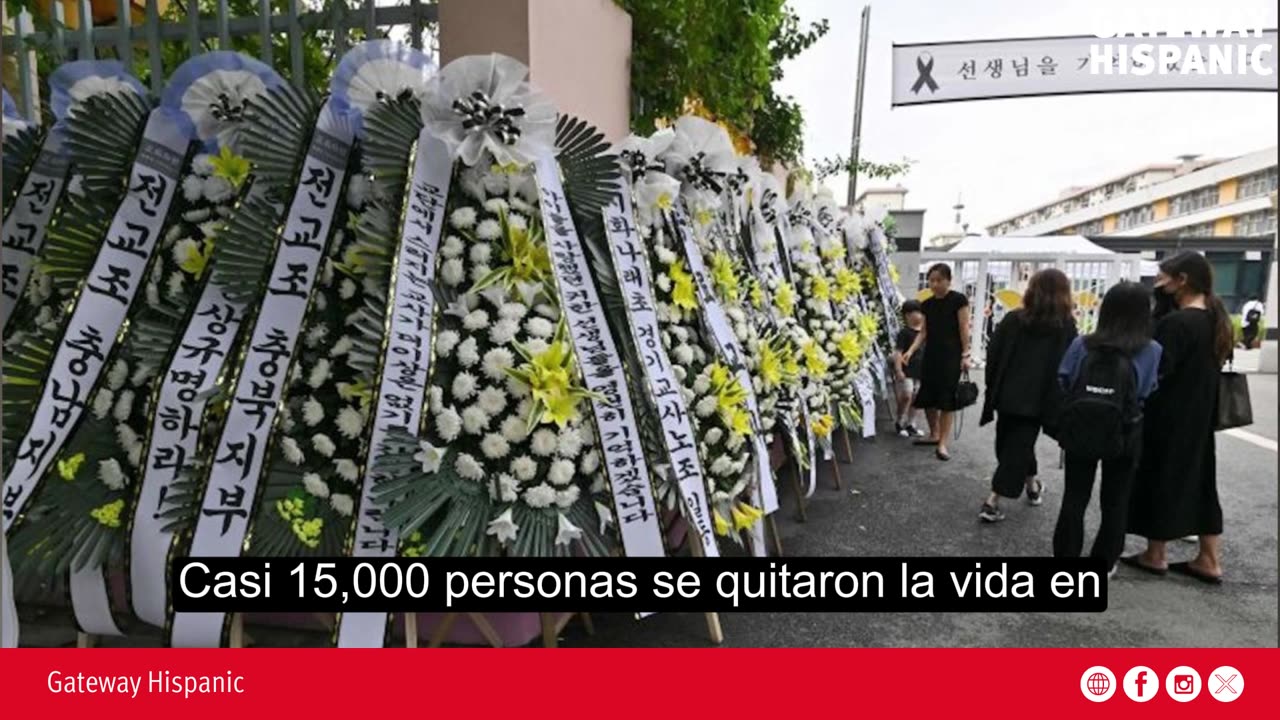Premium Only Content

Suicide, the leading cause of death in South Korea
In 2024, South Korea recorded 14,872 suicides, a 6.4% increase compared to the previous year. This figure marks the highest peak in 13 years, since 2011. The suicide rate reached 29.1 per 100,000 inhabitants. Standardized by the OECD, it stands at 26.2. This is double the organization’s average of 10.8.
South Korea has maintained the negative leadership in the OECD for more than 20 years. In 2023, the rate was 24.3 per 100,000, according to 2021 data processed by the Korea Suicide Prevention Foundation (KFSP).
Suicide ranks as the fifth leading cause of death overall. But among those aged 10 to 49, it is the leading cause. It accounts for 50.1% of deaths among young people aged 9 to 24.
People over 50 account for 22.4% of cases. This group, hit hard by unemployment and poverty, suffers the heaviest burden. In 2024, middle-aged individuals faced severe economic and labor difficulties. Socioeconomic inequality worsens the problem. The rapid post-Korean War growth did not expand public services. It created gaps that affect the disadvantaged, according to experts from Chung-Ang University.
The number of suicides has grown by 40% over the past two decades. Factors such as poverty among the elderly, with nearly half living below the poverty line, drive this trend. In 2023, more than 3,500 people died alone.
Competitive pressure defines South Korean society. The education system, top-ranked in PISA, generates extreme stress. Eleven out of every 100 young people aged 13 to 34 have considered suicide.
In the workplace, South Korea has the longest working hours in the OECD. This fosters instability, with temporary contracts and low wages for young people. The generational and wage gap widens each year.
The taboo surrounding mental illness worsens the crisis. In 2022, more than one million South Koreans suffered from depression. But stigma prevents them from seeking help. The government estimated 13,352 suicides in 2021, with 36 occurring daily.
Cases involving celebrities amplify the effect. The suicide of Lee Sun-kyun in December 2023, the star of Parasite, coincided with a 10.1% increase in the first five months of 2024. Sensationalist coverage triggers imitation. Regions like Gangwon report the highest rate, 37.84 per 100,000. They are followed by Chungnam and Jeonbuk. Among those over 65, Ulsan and Incheon lead. In the 40–59 age group, Daegu ranks first.
Women have the highest female suicide rate in the OECD, at 15 per 100,000. Men have the third highest, at 32.5. Both genders have seen increases since 1986. Post-pandemic isolation worsens everything. In 2023, loneliness caused more deaths than COVID-19 in some groups. In the fall of 2024, Seoul launched a €300 million plan to “eradicate loneliness” within five years.
The Ministry of Health identifies multiple causes: economy, physical and mental health, and lack of community resources. In 2022, there were 12,906 suicides; in 2023, 13,978. The WHO ranks South Korea sixth worldwide, with 28.6 per 100,000 in 2024. It surpasses Lithuania (26.1) and Latvia (20.1).
The Mapo Bridge in Seoul, with its anti-suicide fences, symbolizes the urgency. It installed helpline phones after 846 jumps between 2014 and 2018, with 24 deaths.
In 2025, the government aims to reduce suicides by 50% within 10 years. Plans include weekly therapy and anti-stigma campaigns. But the budget for mental health remains limited.
Fertility, at 0.72 in 2023, aggravates the demographic crisis. Fewer marriages and celibacy fuel isolation.
South Korea, with its obsession with excellence, has built economic giants, but at the cost of souls broken by inequality and loneliness. How many more must fall before progress prioritizes life over GDP?
This is only a warning: unrestrained capitalism, without strong safety nets, does not liberate; it oppresses.
Only a return to traditional values of community and responsibility can heal this open wound.
-
 0:57
0:57
Gateway Hispanic
1 day agoCPAC Mexico is coming in November 2025
91 -
 LIVE
LIVE
Dr Disrespect
2 hours ago🔴LIVE - DR DISRESPECT - BLACK OPS 7 - GIVE ME BACK MY NUKE
1,529 watching -

Neil McCoy-Ward
1 hour agoBanks Now Ordered To SPY On Customers Accounts (UK Safety Act)
231 -
 1:30:40
1:30:40
NAG Podcast
20 hours agoSay Something Beyond W/MikeMac: PATRIOT ROB - Ep.8
62 -
 45:03
45:03
The White House
1 hour agoPress Secretary Karoline Leavitt Briefs Members of the Media, Oct. 6, 2025
5.25K6 -
 1:01:20
1:01:20
Timcast
2 hours agoTexas National Guard DEPLOYED To ILLINOIS, Governor Declares INVASION
92.8K59 -
 2:00:52
2:00:52
The Charlie Kirk Show
2 hours agoThe Killer AG + Kav Assassin's 8 Years + The Battle of Portland | Hemingway, Davis | 10.6.2025
60K22 -
 2:06:01
2:06:01
Steven Crowder
4 hours agoDeport Them All: Trump Takes Fight to Leftist Chicago & Portland Over Attacks on ICE
278K304 -
 1:01:46
1:01:46
The Rubin Report
3 hours agoBill Maher’s Crowd Stunned as Van Jones Gives a Brutal Message to Liberal Media
39.3K56 -
 LIVE
LIVE
Nerdrotic
4 hours ago $1.39 earnedHollywood Will EAT Itself | Amazon BENDS The Knee to 007 Fans - Nerdrotic Nooner 524
442 watching
